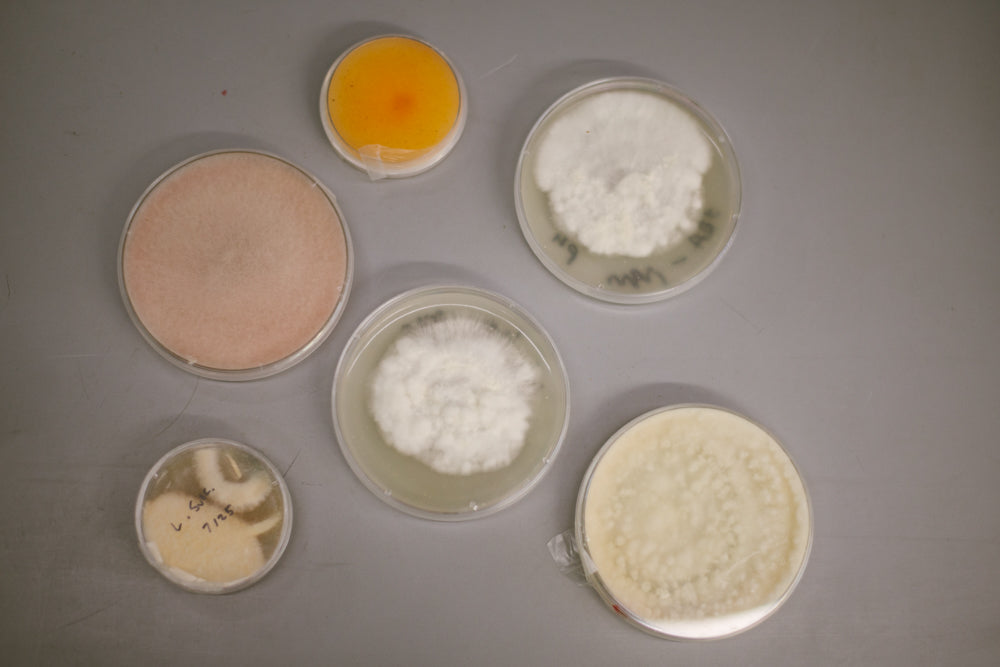What is Mycelium? Today we’re going beyond the fruiting body of the mushroom to the mycelium, which begins the process of expansion and production of mushrooms
Today we are going over the subject of mycelium. Most perceive a fungus only as a mushroom. This is a misconception that has dictated the importance of fungi in our society. Fungi are a diverse kingdom with many species that may never produce a mushroom. Many see a mushroom and believe that this is the entirety of a fungus. However, the mushroom is only a part, or an organ, for certain species, with the intent of producing spores for reproduction. If the mushroom is the fruiting body then what is the rest of the fungus? This begs the question; what collects the nutrients for the fruiting body to fruit?
What is mycelium and why is it so important?
This is where the importance of understanding what mycelium is comes into effect.
Imagine you are walking through the forest and you flip over a log, as forest-walkers occasionally do. On the bottom of the log and on the top of the soil are sporadic white patches. Can you picture it? This is mycelium. So what is mycelium? Mycelium is the vegetative body for fungi that produce mushrooms and, in some cases, species of fungi that never produce a mushroom. When compared to a plant, mycelium is the root system and the mushroom is the flower. When a spore lands on an appropriate substrate under suitable conditions, that spore will germinate. The germination is the beginning of the mycelium from a single meristematic cell. Mycelium consists of the growing 'stem' cells of the fungus. Fungi are heterotrophs so they must attain energy from their surroundings, like humans. Mycelium grows by releasing enzymes from the hyphal tips of the mycelium to digest the surroundings and then absorb the nutrients. The cells will eventually branch and continue to branch as it grows to build a vast, filamentous mycelial network.

When wondering what is mycelium, one must learn about the importance of the role mycelium plays in mycology, plant pathology, and mushroom cultivation. Only by studying and understanding the physiology of mycelium has mushroom cultivation been able to occur. However, in recent decades scientists have begun to realize that the mycelium plays an increasingly more important role in ecosystems than ever considered before. Mycelium is not only growing and consuming for the survival of it's own species but also for the benefit of the entire ecosystem. Want to experience the power of mycelium? Check out our mushroom grow kits here or purchase a pioppino grow kit below.
What is mycelium: Its role in the Ecosystem
Fungi are important in systems because of their innate ability to recycle nutrients which allows the nutrients to become available to other organisms in the environment. Fungi close the energy cycle in ecosystems with decomposition and by breaking down molecules to allow nutrients to be accessible that were previously locked away.
Fungi can be parasitic, saprophytic, or mycorrhizal. Parasitic fungi require a living host to consume and can lead to the eventual death of the host, usually plants. Saprophytic fungi live on dead organic matter and are key to allowing nutrients from the dead become accessible to those of the living. Some fungi can be both parasitic or saprophytic. Most cultivated mushrooms are saprophytic species. However, the form of fungi that really characterizes the incredible abilities of mycelium are those that belong under the term of mycorrhizal. When people ask what is mycelium they are always amazed at the abilities of mycorrhizal fungi.
What is mycelium: Carbon storage facility
Mycorrhizae in latin means; "myco"-fungi and "rhiza"-root. Fungus root. Franciszek Kamieński first termed this name in the late 19th century. It refers to how the mycelium of fungi would literally grow into the roots of plants. Some form "hartig" nets around the first few layers of cells in plant roots; whereas, others will form an organ, called arbuscules or vesicles, that grow inside root cells. This relationship may seem parasitic but it is actually quite the opposite! The relationship that forms is mutually symbiotic. The mycelium will continue to grow through the soil unlocking nutrients, like Phosphorous, that are directed to the plant. In return, the plant will give photosynthates like sugars and carbohydrates to the mycelium which the fungus cannot produce.

The mycelium can even act as a carbon storage facility and will reinvest the carbon into plants in tumultuous times. This relationship is so prevalent that scientists believe 92% of all plants form a mycorrhizal relationship in the soil. This exchange of nutrients is no minor task for a plant to undertake either. It is thought that 40-60% of total photosynthates produced is actually given to the mycelium of the mycorrhizal fungi. This relationship between mycelium and plant life grows even deeper. The mycorrhizal fungi do not simply grow in accordance with one individual but instead connect many individuals throughout the soil. Often one species of mycorrhizal will actually connect species of different plants as well. This type of mycelial network is essential to the health of ecosystems because the mycorrhizae aids in plant communication and even transfers nutrients amongst species. It has been found that plants will actually give nutrients to weaker trees in the community which effectively helps the entire forest. It has been proven that nutrients being recycled from older trees do not always go to older-established trees but instead the mycelium can help the nutrients go to the saplings in the area to help them grow.
Recent studies have even shown that the saplings chosen to receive energy from mycorrhizal mycelium tend to have more characteristics that make them more resilient against the effects of climate change. Mycorrhizal mycelium helps carry forward the energy legacy to the new generation.
Content written by Ben Baldi
Optimization by Chris Sturk

